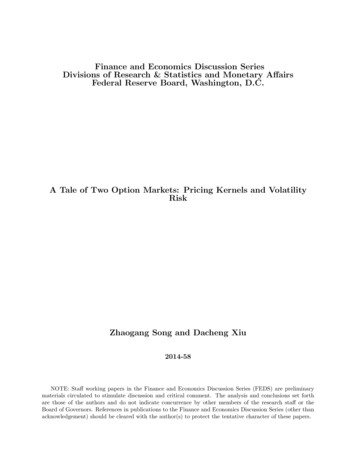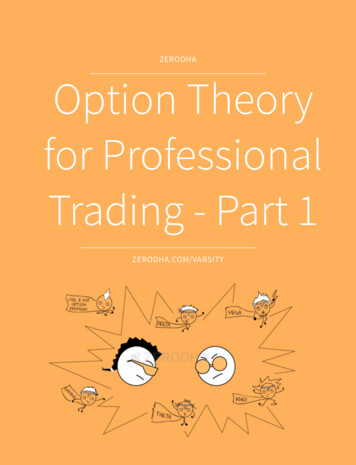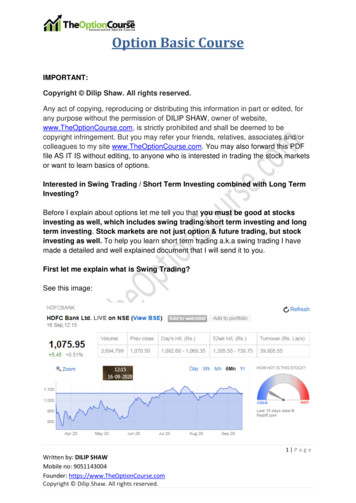
Transcription
Finance and Economics Discussion SeriesDivisions of Research & Statistics and Monetary AffairsFederal Reserve Board, Washington, D.C.A Tale of Two Option Markets: Pricing Kernels and VolatilityRiskZhaogang Song and Dacheng Xiu2014-58NOTE: Staff working papers in the Finance and Economics Discussion Series (FEDS) are preliminarymaterials circulated to stimulate discussion and critical comment. The analysis and conclusions set forthare those of the authors and do not indicate concurrence by other members of the research staff or theBoard of Governors. References in publications to the Finance and Economics Discussion Series (other thanacknowledgement) should be cleared with the author(s) to protect the tentative character of these papers.
A Tale of Two Option Markets: Pricing Kernels andVolatility Risk Zhaogang Song†Dacheng Xiu‡Federal Reserve BoardUniversity of ChicagoThis Version: January, 2014AbstractUsing prices of both S&P 500 options and recently introduced VIX options, westudy asset pricing implications of volatility risk. While pointing out the joint pricingkernel is not identified nonparametrically, we propose model-free estimates of marginalpricing kernels of the market return and volatility conditional on the VIX. We find thatthe pricing kernel of market return exhibits a decreasing pattern given either a high orlow VIX level, whereas the unconditional estimates present a U-shape. Hence, stochastic volatility is the key state variable responsible for the U-shape puzzle documented inthe literature. Finally, our estimates of the volatility pricing kernel feature a U-shape,implying that investors have high marginal utility in both high and low volatility states.Key Words: Pricing Kernel, State-Price Density, VIX Option, Volatility RiskJEL classification: G12,G13 We benefited from discussions with Yacine Aı̈t-Sahalia, Andrea Buraschi, Bjorn Eraker, Peter Carr,Peter Christoffersen, Fousseni Chabi-Yo, George Constantinides, Jianqing Fan, René Garcia, Kris Jacobs,Jakub Jurek, Ilze Kalnina, Ralph Koijen, Nicholas Polson, Eric Renault, Jeffrey Russell, Neil Shephard,George Tauchen (discussant), Viktor Todorov, Grigory Vilkov (discussant), Hao Zhou, as well as seminar andconference participants at the University of Chicago, Northwestern, Princeton, Toulouse School of Economics,Liverpool School of Management, the 2012 CICF, the 5th Annual SoFiE Conference, the Measuring Riskconference 2012, the 2012 Financial Engineering and Risk Management International Symposium, and the2012 International Symposium on Risk Management and Derivatives. Xiu acknowledges research supportby the Fama-Miller Center for Research in Finance at Chicago Booth. The views expressed herein do notreflect those of the Board of Governors of the Federal Reserve System.†Board of Governors of the Federal Reserve System, Mail Stop 165, 20th Street and Constitution Avenue,Washington, DC, 20551. E-mail: Zhaogang.Song@frb.gov.‡University of Chicago Booth School of Business, 5807 S. Woodlawn Avenue, Chicago, IL 60637. Email:dacheng.xiu@chicagobooth.edu.1
1IntroductionIn addition to the uncertainty of market returns, volatility risk has been well documented asan essential component of time-varying investment opportunities. Together with the preferences of economic agents, a priced volatility factor leads to a pricing kernel (or stochasticdiscount factor) which depends on both market returns and volatility. Nevertheless, becausevolatility is neither tradable nor observable, existing studies on pricing kernels either imposestrong parametric restrictions, or ignore the unobservable volatility factor in nonparametricanalysis. The pricing kernel estimates produced by these studies exhibit a puzzling U-shapeas a function of market return, in conflict with a standard expected utility theory.The lack of tradable and observable volatility has changed substantially since the introduction of the Volatility Index (VIX) in 1993 by the Chicago Board of Options Exchange(CBOE),1 and the introduction of VIX derivatives such as futures and options in 2004 and2006, respectively. The VIX, derived from S&P 500 options as the square root of the expected average variance over the next 30 calendar days, provides investors with a directmeasure of volatility; and VIX derivatives offer investors convenient instruments for tradingon the volatility of S&P 500 index.2 As a result, the VIX is constantly exposed in the mediaspotlight, and VIX options have achieved huge liquidity and become the third most activecontracts at CBOE as of October 2011.Taking advantage of the S&P 500 and VIX option markets, we nonparametrically identifyand estimate the marginal pricing kernel of market returns and volatility, which equals theratio of state-price density (or risk-neutral density) to physical density. We show that information in the two option prices is fully captured by the two marginal state-price densities ofmarket returns and volatility separately, whereas the joint state-price density and hence joint1The VIX, from its inception, was calculated from S&P 500 index options by inverting the Black-Scholesformula. In 2003, the CBOE amended this approach and adopted a model-free method to calculate the VIX.2Previously, investors have to take positions in option portfolios, such as straddles or strangles, in orderto trade volatility.1
pricing kernel cannot be identified nonparametrically as a result of incomplete markets.3 Wethen provide nonparametric estimates of pricing kernels with respect to return and volatilityrespectively. Our estimates not only shed light on the puzzling U-shaped pricing kernel, butalso provide new empirical stylized facts on the pricing kernel of volatility. In particular, wemake several important findings regarding asset pricing implications of volatility.First, our estimates of pricing kernels with respect to the market return show that stochastic volatility is the key state variable responsible for the “pricing kernel puzzle.” Morespecifically, we find that a pricing kernel of market return conditional on either a high orlow VIX level presents a decreasing pattern, whereas an unconditional pricing kernel (i.e.the one that ignores volatility) may become U-shaped. In fact, marginal utility (the pricingkernel up to a scaling factor) conditional on high volatility is above that conditional on lowvolatility, as low volatility signals a good investment opportunity and hence is preferred byinvestors. As a mixture of pricing kernel estimates conditional on different volatility levels,unconditional estimates can exhibit an increasing pattern over the high return region (righttail), where high volatility is prevalent. Our finding echoes the conclusions of parametricmodels in Chabi-Yo et al. (2008) and Christoffersen et al. (2010), which show that missingstate variables in the pricing kernel may result in a U-shape. Without restricting the specification of pricing kernels, however, we show that including volatility as a state variable isthe solution to this puzzle.Second, we provide nonparametric estimates of pricing kernels with respect to volatility,for the first time to the best of our knowledge. Our estimates exhibit a pronounced U-shapeconditional on either a high or low VIX, indicating that investors attach high marginalutility to payoffs received in both high and low future volatility states, regardless of today’s3We emphasize that the joint pricing kernel, though not identifiable nonparametrically using the S&P500 and VIX options, can be estimated with certain parametric correlation restriction on the two marginalpricing kernels. We do not explore this approach because our focus is to recover the pricing kernels withoutany parametric restrictions. A follow-up paper of our study, Jackwerth and Vilkov (2013), implemented suchan exercise using the parametric Frank copula for the two marginal distributions.2
volatility level. Bakshi et al. (2010) also document a U-shape for the unconditional volatilitypricing kernel, but indirectly, by exploring the link between the monotonicity of pricingkernel and returns of VIX option portfolios. In contrast, we provide direct estimates ofthe conditional volatility pricing kernel by nonparametric methods, which provide furtherinformation about the shape and tail behavior of the pricing kernel. In particular, we findthat the volatility pricing kernel is asymmetric, and the asymmetry conditional on a currenthigh volatility is much stronger than that conditional on a low volatility. This finding impliesthat market investors price the volatility risk differently according to different scenarios ofthe economy, which presents new empirical regularities that need to be incorporated intomodels of volatility risk.Finally, we evaluate the performance of our nonparametric estimator for in-sample fittingand out-of-sample forecasts against two alternative methods: the nonparametric approach ofAı̈t-Sahalia and Lo (1998) without a volatility factor and a martingale approach commonlyused by practitioners that simply predicts tomorrow’s implied volatility by interpolatingtoday’s implied volatility surface. We find that our estimator outperforms both alternativemethods for density and implied volatility forecasts, which again highlights the importanceof conditioning on volatility.Estimating pricing kernels from option prices is discussed in Aı̈t-Sahalia and Lo (1998),Aı̈t-Sahalia and Duarte (2003), Jackwerth (2000), and Rosenberg and Engle (2002), whichignore the volatility risk and discover a puzzling U-shape.4 Hereafter, many studies have proposed different explanations for the U-shaped pricing kernel, including models with missingstate variables in Chabi-Yo et al. (2008), Chabi-Yo (2011), and Christoffersen et al. (2010),and models with heterogeneous agents in Bakshi and Madan (2008) and Ziegler (2007). Ourempirical study contributes to this literature by showing, without imposing any parametricrestrictions, that volatility is the missing state variable responsible for the puzzle.4A related study, Fan and Mancini (2009), proposes nonparametric methods for pricing derivatives basedon state price distributions.3
Our paper is also related to the large literature on models with volatility risk, includingboth reduced-form option pricing models, e.g. Bakshi et al. (1997), Bates (2000), Pan (2002),Eraker (2004), and Broadie et al. (2007), and equilibrium models, such as Bansal et al. (2012),Bollerslev et al. (2012), and Campbell et al. (2012). Unlike these studies, our frameworkdoes not depend on any parametric restrictions on volatility dynamics that may obscure theempirical characteristics of pricing kernels. Several recent studies have constructed modelfree measures of risk-neutral volatility from S&P 500 options, e.g. Bakshi and Kapadia(2003), Bollerslev et al. (2009), Carr and Wu (2009), and Todorov (2010), and comparedthem with measures of realized volatility. Their focuses are on the sign, time variation, andreturn predictability of variance risk premium, which only relates to the conditional mean ofvariance distributions under different measures. In contrast, we recover the entire volatilitypricing kernel.Methodologically, our paper is also related to Boes et al. (2007) and Li and Zhao (2009)who estimate pricing kernels of stock market returns and interest rates, respectively, conditional on an ex-post volatility proxy filtered from historical time series. Our strategy differsfrom their approach by using the VIX, which possesses a monotonic functional relationshipwith the unobservable volatility for almost all state-of-the-art volatility models. Therefore,our method avoids estimation errors from the filtering stage, while making it possible tostudy volatility pricing kernels with the help of VIX options.Furthermore, several recent studies document the importance of multiple volatility factorsin capturing dynamics of option prices or the term structure of variance swaps, see e.g.Christoffersen et al. (2008), Egloff et al. (2010), Mencia and Sentana (2012), and Bates(2012). Our nonparametric framework can be extended to nest these models by includingadditional regressors such as a VIX future contract, or CBOE S&P 500 3-Month VolatilityIndex (VXV). Such an extension, though being interesting and important itself, is beyondthe scope of the current focus, to which term structure of volatility is less relevant.4
Section 2 discusses the nonparametric identification of pricing kernels of both the marketreturn and volatility. Section 3 provides our nonparametric estimation framework and MonteCarlo simulations. Empirical estimates of pricing kernels are presented in Section 4. Section5 concludes the paper.2Pricing Kernels with a Volatility FactorThe pricing kernel equals the ratio of risk-neutral density, also known as state-price density(SPD), to the density under the physical measure. To study pricing kernels, we first discussthe identification of state price densities, by exploring the underlying connection of S&P 500options, VIX, and VIX options through the latent volatility factor.2.1Identification of State-Price DensitiesTo fix ideas, we denote the log price of the S&P 500 index as St , the VIX as Zt , and theunobserved volatility as Vt . The information in the derivative markets is driven by the jointevolution of St and Vt , which determines Zt endogenously. As Vt is not observable, thereexist no Arrow-Debreu securities traded on Vt directly.In fact, the payoffs of S&P 500 and VIX options depend on their own underlying indicesat maturity T . Therefore, we focus on the marginal state-price densities with respect to Sand Z separately. We show that the marginal densities together span the two option markets,and provide sufficient and necessary information about the dynamics of the market returnand its volatility. The joint dynamics, nevertheless, cannot be identified nonparametricallyunless certain options whose payoff depends on both ST and ZT are traded.5
We write the time-t price of a S&P 500 call option with maturity T and strike x as:5[] C(τ, ft,τ , vt , x, rt,τ ) e rt,τ τ E Q (eST x) Ft,τ ft,τ , Vt vt rt,τ τ e(esT x) p (sT τ, ft,τ , vt )dsTRwhere Ft,τ denotes the log forward price of the S&P 500 index, τ T t is the time-tomaturity, and rt,τ is the deterministic risk-free rate between t and T at time t. Similarly, theprice of a VIX call option with strike y is given by:[]H(τ, ft,τ , vt , y, rt,τ ) e rt,τ τ E Q (ezT y) Ft,τ ft,τ , Vt vt rt,τ τ e(ezT y) q (zT τ, ft,τ , vt )dzTRObserve that the two SPDs p (sT τ, ft,τ , vt ) and q (zT τ, ft,τ , vt ) completely determinethese option prices. Building upon the insight of Breeden and Litzenberger (1978), they canbe estimated as the second order derivative of option prices with respect to different strikes.In particular, we can recoverp (sT τ, ft,τ , vt ) ert,τ τ sT 2 C(τ, ft,τ , vt , x, rt,τ ) x2x esT,(1)from S&P 500 options andq (zT τ, ft,τ , vt ) ert,τ τ 2 H(τ, ft,τ , vt , y, rt,τ ) y 2,(2)y zTfrom VIX options. It is apparent that p (sT τ, ft,τ , vt ) and q (zT τ, ft,τ , vt ) summarize theentire information about these two option markets, hence the joint density of sT and zTcannot be identified from the data without additional parametric assumptions.Nevertheless, these two densities p (sT τ, ft,τ , vt ) and q (zT τ, ft,τ , vt ) are not practicallyfeasible to estimate as Vt is unobservable. Alternatively, with the observed VIX from theIn our setting, the time-t information set Ft contains stock prices, instantaneous volatility, interest ratesand dividends, which can be summarized by the log forward price Ft,τ and the volatility Vt .56
market,6 we may rewrite the option prices with zt as a state variable, i.e., C(τ, ft,τ , zt , x, rt,τ )and H(τ, ft,τ , zt , y, rt,τ ),7 and take second order derivatives to obtain 2 C(τ, ft,τ , zt , x, rt,τ ) x2x esT2 H(τ, ft,τ , zt , y, rt,τ ).q (zT τ, ft,τ , zt ) ert,τ τ y 2y zTp (sT τ, ft,τ , zt ) ert,τ τ sT(3)In fact, writing options in terms of ft,τ and zt amounts to assuming that Vt can be determinedfrom Zt and Ft,τ , which is rigorous under most models of volatility risk in the literature (seeSection 2.3 below for details). With state variables being fully observable, p (sT τ, ft,τ , zt )and q (zT τ, ft,τ , zt ) can be identified from the data.In summary, state-price densities p (sT τ, ft,τ , zt ) and q (zT τ, ft,τ , zt ) encapsulate all theinformation in the two option markets. They complement each other to reveal an intactpicture of the market return, its volatility dynamics and the interactions of the two markets.2.2From State-Price Densities to Pricing KernelsWe now discuss how to obtain the pricing kernels by combining the risk-neutral and physicaldensities of St and Zt . We denote π(sT , zT τ, ft,τ , zt ) as the pricing kernel and use π forshort. Not surprisingly, for the same reason described in Section 2.1, the joint pricingkernel π (sT , zT τ, ft,τ , zt ) cannot be identified nonparametrically. We therefore study theprojections of pricing kernel π on ST 8 and ZT , denoted as π(sT τ, ft,τ , zt ) and π(zT τ, ft,τ , zt ),respectively. They are called the pricing kernel of the market return and the pricing kernel6The CBOE constructs Zt form a portfolio of options weighted by strikes according to the formula:2ert,τ τ ((Zt /100) E (QVt,τ Ft ) τ2Q eft,τ0P (τ, x)dx x2 eft,τC(τ, x) )dx ϵx2where QVt,T denotes the quadratic variation of the log return process from t to t τ , P (τ, x) and C(τ, x)are put and call options with time-to-maturity τ and strike x, and ft,τ is the log price of forward contracts,see e.g. Britten-Jones and Neuberger (2000) and Carr and Wu (2009).7Strictly speaking, the function C (·) here is a composite function, which is different from the previouscall option pricing function. We recycle it to simplify our notations.8The projection of π on ST is defined as E P (π ST sT , Ft,τ ft,τ , Zt zt ).7
of the VIX in the following.In fact, the price of a S&P 500 call option can be written as[] C(τ, ft,τ , zt , x, rt,τ ) e rt,τ τ E P π · (eST x) Ft,τ ft,τ , Zt zt rt,τ τ eπ (sT τ, ft,τ , zt ) (esT x) p(sT τ, ft,τ , zt )dsT ,(4)Rand the price of a VIX call option is[]H(τ, ft,τ , zt , y, rt,τ ) e rt,τ τ E P π · (ezT y) Ft,τ ft,τ , Zt zt rt,τ τ eπ (zT τ, ft,τ , zt ) (ezT y) q(zT τ, ft,τ , zt )dzT ,(5)Rwhere p(sT τ, ft,τ , zt ) and q(zT τ, ft,τ , zt ) are conditional densities of ST and ZT under thephysical measure, respectively. Note that the law of iterated expectation is used in thesecond equality of both (4) and (5).Similar to (3), equations (4) and (5) imply that the second order derivatives of the S&P500 and VIX call prices with respect to their strikes are also equal to π (sT τ, ft,τ , zt ) p(sT τ, ft,τ , zt )and π (zT τ, ft,τ , zt ) q(zT τ, ft,τ , zt ), respectively. This fact, combined with (3), further impliesthatp (sT τ, ft,τ , zt )p(sT τ, ft,τ , zt )q (zT τ, ft,τ , zt )π (zT τ, ft,τ , zt ) q(zT τ, ft,τ , zt )π (sT τ, ft,τ , zt ) That is, by combining the risk-neutral and physical densities of St and Zt , we obtain theprojections of π onto ST and ZT , respectively. These two pricing kernels contain rich information on how risks, especially those associated with volatility shocks, are priced in financialmarkets. In the equilibrium setup of Aı̈t-Sahalia and Lo (2000) with a representative agent,these pricing kernels represent—up to a scaled factor—the marginal rate of substitution.While Aı̈t-Sahalia and Lo (2000) and Jackwerth (2000) estimate the pricing kernels of S&P500 returns, our π (sT τ, ft,τ , zt ) includes the VIX zt in the conditional information set so that8
volatility becomes relevant to the price of risk regarding the expected returns. In addition,we are able to identify the pricing kernel of the VIX.2.3Nested ModelsAs discussed in Section 2.1, we employ the information set generated by Ft,τ and Zt toreplace the information generated by Ft,τ and Vt , because Zt is directly observable. Infact, the information set of Ft,τ and Zt is coarser than the set generated by Ft,τ and Vt ,and equating these two effectively assumes that Vt is an invertible function of Ft,τ and Zt .We now show that this assumption is satisfied in most parametric models proposed in theliterature, including both reduced-form option pricing models and equilibrium models witha priced stochastic volatility factor. Unlike Boes et al. (2007) and Li and Zhao (2009) whouse an ex-post volatility proxy filtered from historical time series, we use VIX instead, whichbears no approximation errors in most cases.We first consider the class of option pricing models that induce an affine relationshipbetween the unobservable variance and squared VIX. This class of models has the followingrisk-neutral dynamics:9 1dSt (r d Vt )dt Vt dWtQ dLSt2dVt κ(ξ Vt )dt σ(Vt )dBtQ dLVt(6)where dLSt and dLVt may be driven by finite activity compound Poisson processes withcorrelated jump sizes JtS and JtV . Such models include those discussed in Bakshi et al.(1997), Bates (2000), Pan (2002), Chernov and Ghysels (2000), Eraker (2004), Carr et al.(2003), Eraker et al. (2003), and Broadie et al. (2007). Jumps can be driven by Lévyprocesses such as the CGMY process in Carr et al. (2003) and Bates (2012). Note thatthis class also includes non-Gaussian OU processes, as introduced in Barndorff-Nielsen and9The discontinuous part of the quadratic variation of St is assumed to be linear in V .9
Shephard (2001); see Shephard (2005) for a collection of similar models.For models of this class, we haveZt2 aVt b,where a and b are functions of model parameters (see Carr and Wu (2009) for details). Thatis, Zt2 is a linear function of Vt , hence Zt and Vt deliver the same information set.The second class of models introduces a non-affine structure between the squared VIXand variance, such as the exponential-OU-L models in Shephard (2005). In particular, underthe risk-neutral measure, such models specify the volatility process aslog Vt α βFt ,dFt κFt dt dLt ,The squared VIX, as calculated by Tauchen and Todorov (2011), is ()1 τ2Zt γ (η 1) exp α eκu (log Vt α) C(u) du,τ 0(7)where C(u) is determined by the characteristic exponent of the Lévy process Lt , and γ andη are constants determined by the quadratic variation of LSt . Observe that the functionVt 7 Zt is invertible, so that the information sets generated by Vt and by Zt are equivalent.Finally, we consider a stylized general equilibrium model, which is a simplified versionof Bollerslev et al. (2009) and Drechsler and Yaron (2011) that builds on the long-run riskframework of Bansal and Yaron (2004).10 Specifically, the representative agent’s preferenceover consumption is recursive (Epstein and Zin (1989)). Therefore, the log pricing kernel attime t 1 ismt 1 θ log δ θψ 1 ct 1 (θ 1)rc,t 1 ,(8)where θ (1 γ)/(1 ψ 1 ), 0 δ 1 is the subjective discount factor, γ is the risk10Other equilibrium models that satisfy the invertibility between Zt and Vt include Bansal et al. (2012),Bollerslev et al. (2009), and Campbell et al. (2012). We choose to present the framework of Bollerslev et al.(2009) and Drechsler and Yaron (2011) for simplicity of illustration.10
aversion coefficient, ψ is the intertemporal elasticity of substitution, ct 1 is the growthrate of log consumption, and rc,t 1 is the time t to t 1 return on the aggregate wealthclaim.11 The state vector of the economy follows ct 1 µc σc,t zc,t 1 Jc,t 122σc,t 1 µσ ρσ σc,t σc,t zσ,t 1 Jσ,t 1(9)where {zc,t } and {zσ,t } are independent i.i.d. N(0,1) processes, Jc,t 1 is a compound Poissonprocess with intensity λc,t and i.i.d. jump size ζic , Jσ,t 1 is a compound Poisson process withintensity λσ,t and i.i.d. jump size ζiσ , and both jump processes are independent of each otherand of the Gaussian shocks. Note that both the Gaussian process zσ,t 1 and jump processJσ,t 1 contribute to volatility shocks.By the standard log-linearization approach following Campbell and Shiller (1988), wehaverc,t 1 κ0 κ1 wt 1 wt ct 1 ,(10)where the price-wealth ratio wt is conjectured to be affine in the state vector:2wt A0 Aσ σc,t(11)with A0 0 and Aσ 0 as functions of the model parameters we suppress for notationalbrevity. With (10) and (11), we have22rc,t 1 ct 1 κ1 Aσ σc,t 1 Aσ σc,t κ0 κ1 A 0 A 0 .2shows up in rc,t 1 , and hence in the pricing kernel mt 1Therefore, the volatility factor σc,t 1given in (8). Following the standard practice to proxy the aggregate wealth (consumption)by the aggregate stock market St (see Aı̈t-Sahalia and Lo (2000), Bansal and Yaron (2004),11The literature usually assumes that γ 1 and ψ 1, which implies θ 0. This assumption ensuresthat the representative agent has a preference for early resolution of uncertainty, which is the key for theprice of volatility risk.11
and Campbell et al. (2012)), the return ST St corresponds to ct 1 , and Zt corresponds2to the square root of the risk-neutral expectation of the consumption growth variance σc,t.Although the state vector dynamics are specified in discrete time, the model (9) is actuallya special case of the affine model in Bollerslev et al. (2012). Therefore, Zt is an invertible2function of Vt σc,t 1, which represents the variance of consumption growth rate under thisequilibrium model.In summary, most parametric models with volatility risk proposed in the literature,whether reduced-form or structural, can be nested within our nonparametric framework.As a result, we do not lose any information about the dynamics of St and Vt when incorporating Zt into the information set; instead, the implementation becomes feasible with theinformation set fully observable.33.1Estimation StrategyMultivariate Local Linear Estimators for DensitiesHere we introduce our nonparametric estimation strategies for SPDs. To fix ideas, we assumethe observed prices, C̃ and H̃, are contaminated with observation errors, such that12()C(τ, ft,τ , zt , x) E C̃ τ̃ τ, Ft,τ ft,τ , Zt zt , X x()H(τ, ft,τ , zt , y) E H̃ τ̃ τ, Ft,τ ft,τ , Zt zt , Y y .We then construct nonparametric estimators of C and H, and take derivatives to estimatethe SPDs. Different from the multivariate kernel regression approach adopted by Aı̈t-Sahaliaand Lo (1998), we prefer the local linear estimator (Fan and Gijbels (1996)) for two mainreasons. First of all, the bias and variance of local polynomial estimators are of the sameHereafter, we multiply all option prices by the corresponding ert,τ τ , so that we can omit rt,τ in C and H,and reduce one state variable in the following regressions. Again, we recycle the notations C and H withoutambiguity.1212
order of magnitude in the interior or near the boundary, whereas kernel estimators arenotorious for the boundary effects. As our empirical studies focus on the tail of pricingkernels, it is advantageous to adopt more efficient estimators. Second, local polynomialregression provides estimates of derivatives, in addition to option prices, which makes itmore convenient for our purpose.Theoretically, it is better to use a local cubic estimator to obtain second-order derivatives.Since we have more than one state variable, including all cross-terms of cubic polynomialsinto the regression is cumbersome. We avoid this by applying the local linear estimator, sothat estimators for SPDs can be obtained simply by a first-order differentiation with respectto the strike.We write the option price C as a function of u (τ, f, z, x)′ , and consider the followingminimization problem,minα,βn {Ci α β ′ (ui u)} Kh (ui u)2i 1where ui (τ i , fti ,τi , zti , xi )′ and Ci are the characteristics and price respectively of thei-th option in the sample. Kh is a kernel function scaled by a bandwidth vector h (hτ , hf , hz , hx )′ :1Kh (ui u) khτ(τi τhτ)1khf(fti ,τi fhf)1khz(zti zhz)1khx(xi xhx)(12)where k (·) is, for example, the density a of standard normal distribution. The minimizerhas a closed-form representation: b α bβ 1 (Ω′ KΩ)(1 4) 113Ω′ KC(13)
where Ω ′1 (u1 u).1 (un u)′ , C C1. , Kh (u1 u) .K . CnKh (un u) . The nonparametric local linear estimator for the option pricing function C(τ, f, z, x) is 1b f, z, x) αC(τ,b e′1 (Ω′ KΩ) Ω′ KC,with e1 (1, 0, 0, 0)′ and the estimator pb (s′ τ, f, z) for the SPD of St is)( ′ 1′bΩ′ KC′ β4′ e5 (Ω KΩ)′ss pb (s τ, f, z) e e.′ x x es′ xx es(14)(15)b (·) and qb (z ′ τ, s, z) can be conwhere e5 (0, 0, 0, 0, 1)′ . The nonparametric estimator Hstructed similarly.b in our local linear regression (13) provides estimatesIt may be worth pointing out that βof option Greeks. Specifically, option Theta is given by by e′1 β C/ τ , Delta by e′2 β · es ,and Vega by e′3 β.3.2Dimension ReductionOne of the major issues of nonparametric estimation is the curse of dimensionality. The rateof convergence decreases rapidly as the dimension of state variables increases. In the mostgeneral forms, the pricing functions C (·) and H (·) depend not only on time-to-maturity,strike, VIX, and the S&P 500 index, but also on interest rates and dividends. Instead ofregressing on additional interest rate and dividend variables, we assume that option pricesmultiplied by ert,τ τ depend on these variables only through forward prices. As mentioned inAı̈t-Sahalia and Lo (1998), models that violate this assumption seem very remote empirically.Furthermore, following many existing studies such as Aı̈t-Sahalia and Lo (1998) and Liand Zhao (2009), we assume that the S&P 500 option price is homogeneous of degree one in14
the forward price level:C(τ, f, z, x) ef C(τ, 0, z, x/ef ) ef C̄(τ, z, m)(16)where m x/ef represents the moneyness of the option. Consequently, we obtain theestimate of C(τ, f, z, x) through multiplying the nonparametric estimate of C̄ (·) by
tic volatility is the key state variable responsible for the U-shape puzzle documented in the literature. Finally, our estimates of the volatility pricing kernel feature a U-shape, implying that investors have high marginal utility in both high and low volatility states. Key Words: Pricing Kernel, State-Price Density, VIX Option, Volatility .











